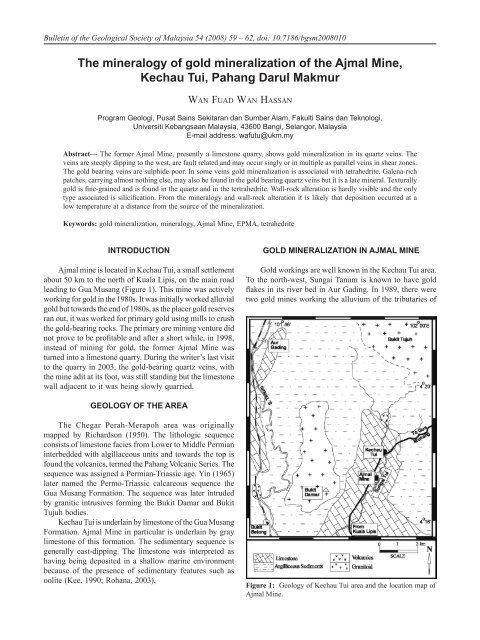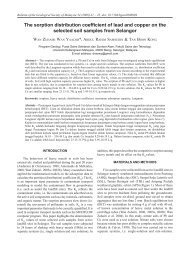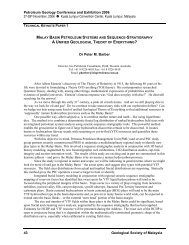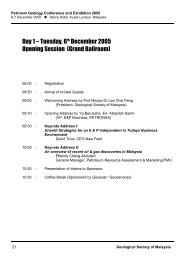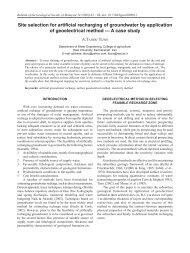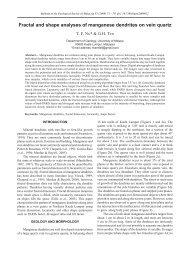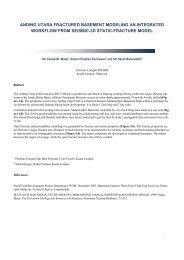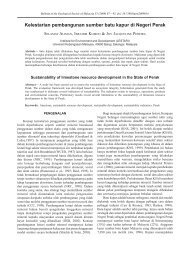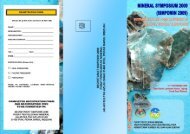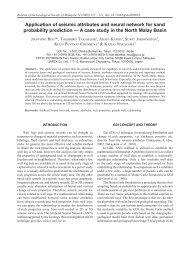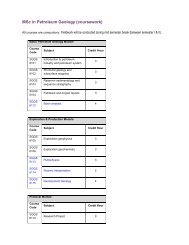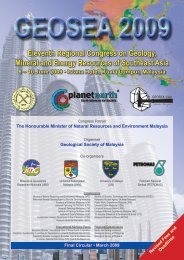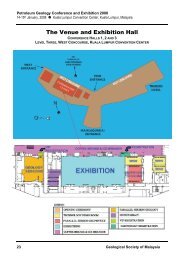The mineralogy of gold mineralization of the Ajmal Mine, Kechau Tui ...
The mineralogy of gold mineralization of the Ajmal Mine, Kechau Tui ...
The mineralogy of gold mineralization of the Ajmal Mine, Kechau Tui ...
You also want an ePaper? Increase the reach of your titles
YUMPU automatically turns print PDFs into web optimized ePapers that Google loves.
Bulletin <strong>of</strong> <strong>the</strong> Geological Society <strong>of</strong> Malaysia 54 (2008) 59 – 62, doi: 10.7186/bgsm2008010<br />
<strong>The</strong> <strong>mineralogy</strong> <strong>of</strong> <strong>gold</strong> <strong>mineralization</strong> <strong>of</strong> <strong>the</strong> <strong>Ajmal</strong> <strong>Mine</strong>,<br />
<strong>Kechau</strong> <strong>Tui</strong>, Pahang Darul Makmur<br />
Wa n Fu a d Wa n Ha s s a n<br />
Program Geologi, Pusat Sains Sekitaran dan Sumber Alam, Fakulti Sains dan Teknologi,<br />
Universiti Kebangsaan Malaysia, 43600 Bangi, Selangor, Malaysia<br />
E-mail address: wafutu@ukm.my<br />
Abstract— <strong>The</strong> former <strong>Ajmal</strong> <strong>Mine</strong>, presently a limestone quarry, shows <strong>gold</strong> <strong>mineralization</strong> in its quartz veins. <strong>The</strong><br />
veins are steeply dipping to <strong>the</strong> west, are fault related and may occur singly or in multiple as parallel veins in shear zones.<br />
<strong>The</strong> <strong>gold</strong> bearing veins are sulphide-poor. In some veins <strong>gold</strong> <strong>mineralization</strong> is associated with tetrahedrite. Galena-rich<br />
patches, carrying almost nothing else, may also be found in <strong>the</strong> <strong>gold</strong> bearing quartz veins but it is a late mineral. Texturally<br />
<strong>gold</strong> is fine-grained and is found in <strong>the</strong> quartz and in <strong>the</strong> tertrahedrite. Wall-rock alteration is hardly visible and <strong>the</strong> only<br />
type associated is silicification. From <strong>the</strong> <strong>mineralogy</strong> and wall-rock alteration it is likely that deposition occurred at a<br />
low temperature at a distance from <strong>the</strong> source <strong>of</strong> <strong>the</strong> <strong>mineralization</strong>.<br />
Keywords: <strong>gold</strong> <strong>mineralization</strong>, <strong>mineralogy</strong>, <strong>Ajmal</strong> <strong>Mine</strong>, EPMA, tetrahedrite<br />
Introduction<br />
<strong>Ajmal</strong> mine is located in <strong>Kechau</strong> <strong>Tui</strong>, a small settlement<br />
about 50 km to <strong>the</strong> north <strong>of</strong> Kuala Lipis, on <strong>the</strong> main road<br />
leading to Gua Musang (Figure 1). This mine was actively<br />
working for <strong>gold</strong> in <strong>the</strong> 1980s. It was initially worked alluvial<br />
<strong>gold</strong> but towards <strong>the</strong> end <strong>of</strong> 1980s, as <strong>the</strong> placer <strong>gold</strong> reserves<br />
ran out, it was worked for primary <strong>gold</strong> using mills to crush<br />
<strong>the</strong> <strong>gold</strong>-bearing rocks. <strong>The</strong> primary ore mining venture did<br />
not prove to be pr<strong>of</strong>itable and after a short while, in 1998,<br />
instead <strong>of</strong> mining for <strong>gold</strong>, <strong>the</strong> former <strong>Ajmal</strong> <strong>Mine</strong> was<br />
turned into a limestone quarry. During <strong>the</strong> writer’s last visit<br />
to <strong>the</strong> quarry in 2003, <strong>the</strong> <strong>gold</strong>-bearing quartz veins, with<br />
<strong>the</strong> mine adit at its foot, was still standing but <strong>the</strong> limestone<br />
wall adjacent to it was being slowly quarried.<br />
Gold <strong>mineralization</strong> in <strong>Ajmal</strong> <strong>Mine</strong><br />
Gold workings are well known in <strong>the</strong> <strong>Kechau</strong> <strong>Tui</strong> area.<br />
To <strong>the</strong> north-west, Sungai Tanum is known to have <strong>gold</strong><br />
flakes in its river bed in Aur Gading. In 1989, <strong>the</strong>re were<br />
two <strong>gold</strong> mines working <strong>the</strong> alluvium <strong>of</strong> <strong>the</strong> tributaries <strong>of</strong><br />
Geology <strong>of</strong> <strong>the</strong> Area<br />
<strong>The</strong> Chegar Perah-Merapoh area was originally<br />
mapped by Richardson (1950). <strong>The</strong> lithologic sequence<br />
consists <strong>of</strong> limestone facies from Lower to Middle Permian<br />
interbedded with algillaceous units and towards <strong>the</strong> top is<br />
found <strong>the</strong> volcanics, termed <strong>the</strong> Pahang Volcanic Series. <strong>The</strong><br />
sequence was assigned a Permian-Triassic age. Yin (1965)<br />
later named <strong>the</strong> Permo-Triassic calcareous sequence <strong>the</strong><br />
Gua Musang Formation. <strong>The</strong> sequence was later intruded<br />
by granitic intrusives forming <strong>the</strong> Bukit Damar and Bukit<br />
Tujuh bodies.<br />
<strong>Kechau</strong> <strong>Tui</strong> is underlain by limestone <strong>of</strong> <strong>the</strong> Gua Musang<br />
Formation. <strong>Ajmal</strong> <strong>Mine</strong> in particular is underlain by gray<br />
limestone <strong>of</strong> this formation. <strong>The</strong> sedimentary sequence is<br />
generally east-dipping. <strong>The</strong> limestone was interpreted as<br />
having being deposited in a shallow marine environment<br />
because <strong>of</strong> <strong>the</strong> presence <strong>of</strong> sedimentary features such as<br />
oolite (Kee, 1990; Rohana, 2003),<br />
Figure 1: Geology <strong>of</strong> <strong>Kechau</strong> <strong>Tui</strong> area and <strong>the</strong> location map <strong>of</strong><br />
<strong>Ajmal</strong> <strong>Mine</strong>.
Wa n Fu a d Wa n Ha s s a n<br />
Sungai <strong>Tui</strong> a few kilometers to <strong>the</strong> north <strong>of</strong> <strong>Ajmal</strong> <strong>Mine</strong><br />
(Kee, 1990). <strong>Ajmal</strong> <strong>Mine</strong> was originally an alluvial mine<br />
working <strong>the</strong> alluvial ground <strong>of</strong> Sungai <strong>Tui</strong>. <strong>The</strong> pinnacled<br />
limestone bedrock <strong>of</strong>fers many potholes that acted as traps<br />
where rich <strong>gold</strong> concentrates were obtained.<br />
<strong>The</strong> primary <strong>gold</strong> <strong>mineralization</strong> in <strong>the</strong> area seems to<br />
be related to <strong>the</strong> igneous intrusions in <strong>the</strong> area. To <strong>the</strong> east<br />
is a small granite pluton named Bukit Damar and to <strong>the</strong><br />
north-east is <strong>the</strong> Bukit Tujuh granite. <strong>The</strong> igneous intrusions<br />
were thought to have been emplaced in <strong>the</strong> Triassic-Jurassic<br />
period.<br />
Primary <strong>gold</strong> <strong>mineralization</strong> in <strong>Ajmal</strong> <strong>Mine</strong> occurs as<br />
<strong>gold</strong>-bearing quartz veins transecting <strong>the</strong> Permian limestone<br />
bedrocks. <strong>The</strong> veins are generally steeply dipping to <strong>the</strong><br />
west (at about 70 o ) and fault-related. Some exist as single,<br />
20-30 cm thick veins while o<strong>the</strong>rs may exist as thin (a few<br />
cm) parallel veins in a shear zone (Figure 2). <strong>The</strong> faults<br />
strike approximately N-S and NE-SW.<br />
<strong>The</strong>re are two types <strong>of</strong> mineralized veins in this<br />
mine, viz., i) sulphide rich, <strong>gold</strong> poor quartz veins and ii)<br />
sulphide poor <strong>gold</strong> bearing quartz veins. <strong>The</strong> main <strong>gold</strong><br />
<strong>mineralization</strong> occurs in N-S trending sulphide-poor veins.<br />
<strong>The</strong> sulphide in <strong>the</strong> sulphide-poor veins consists mainly <strong>of</strong><br />
an olive-grey minerals later identified as tetrahedrite, galena<br />
and traces <strong>of</strong> chacopyrite and sphalerite. Gold is found in<br />
<strong>the</strong>se veins, as little specks <strong>of</strong> free <strong>gold</strong>, in <strong>the</strong> white quartz<br />
away from <strong>the</strong> main galena mass and also as little specks<br />
in <strong>the</strong> tetrahedrite. In parts, <strong>the</strong>re may also be patches <strong>of</strong><br />
galena in <strong>the</strong>se veins but <strong>the</strong> galena is a late mineral. <strong>The</strong><br />
<strong>gold</strong> was deposited earlier in <strong>the</strong> quartz, and later, toge<strong>the</strong>r<br />
with tetrahedrite.<br />
<strong>The</strong> second type is <strong>the</strong> galena-rich quartz veins.<br />
Wea<strong>the</strong>red galena appears as black material in <strong>the</strong> white<br />
quartz. Fresh surfaces show galena as medium grained,<br />
shining silvery gray scaly mineral that occurs by itself.<br />
<strong>The</strong>re may also be specks <strong>of</strong> <strong>gold</strong> grains in <strong>the</strong>se quartz<br />
veins but it occurs in <strong>the</strong> white quartz away from <strong>the</strong> galena.<br />
<strong>The</strong> galena rarely occurs with o<strong>the</strong>r sulphides. A close<br />
examination may also show <strong>the</strong> presence <strong>of</strong> a fine-grained<br />
<strong>of</strong>f-white carbonate mineral toge<strong>the</strong>r with <strong>the</strong> quartz. This<br />
carbonate, which effervesces on contact with acid, and is<br />
clean and fine-grained, probably brought toge<strong>the</strong>r with quartz<br />
by <strong>the</strong> mineralizing solution. Micro-veinlets <strong>of</strong> galena may<br />
cut both <strong>the</strong> quartz and <strong>the</strong> carbonate indicating that galena<br />
is a later mineral.<br />
Gold itself appears as minute specks in <strong>the</strong> quartz and in<br />
<strong>the</strong> tetrahedrite sulphide, but is rarely present in <strong>the</strong> galenarich<br />
part. It seems that early <strong>gold</strong> was deposited toge<strong>the</strong>r with<br />
<strong>the</strong> early quartz in <strong>the</strong> veins. A second generation <strong>of</strong> <strong>gold</strong><br />
was brought toge<strong>the</strong>r with tetrahedrite. <strong>The</strong> galena bearing<br />
late solution seems to have been depleted in <strong>gold</strong>.<br />
60<br />
Microscopic study<br />
Native <strong>gold</strong> is observed in two occurrences, viz. in<br />
white quartz and in <strong>the</strong> tetrahedrite. In both, <strong>gold</strong> is more<br />
common in <strong>the</strong> tetrahedrite-bearing quartz veins ra<strong>the</strong>r than<br />
<strong>the</strong> galena-rich variety. Sulphides consist <strong>of</strong> two major<br />
components, viz. galena and tetrahedrite. Galena seems to<br />
appear at a later stage in <strong>the</strong> <strong>mineralization</strong>, and does not<br />
carry much <strong>gold</strong>, o<strong>the</strong>r than some small <strong>gold</strong> specks observed<br />
in <strong>the</strong> galena-rich part. In <strong>the</strong> same vein, whenever <strong>the</strong>re<br />
is galena, <strong>gold</strong> specks may appear in <strong>the</strong> white quartz but<br />
not in <strong>the</strong> galena-rich part.<br />
Polished section study shows galena as <strong>the</strong> main<br />
sulphide in <strong>the</strong> galena-rich sample and o<strong>the</strong>r sulphides are<br />
rarely found. In <strong>the</strong> tetrahedrite-rich sections, tetrahedrite<br />
is <strong>the</strong> main mineral toge<strong>the</strong>r with some chalcopyrite and<br />
sphalerite engulfed by galena. Tetrahedrite boundaries in<br />
contact with <strong>the</strong> galena are rounded, convex-outwards,<br />
indicating that it has been corroded by galena and that<br />
tetrahedrite is <strong>the</strong> earlier mineral. Gold somehow appears<br />
in <strong>the</strong> tetrahedrite only and rarely in <strong>the</strong> galena.<br />
In <strong>the</strong> quartz, <strong>gold</strong> occurs as free disseminated grains<br />
along micr<strong>of</strong>ractures. Its grain size is fine, seldom exceeding<br />
1 mm. In <strong>the</strong> tetrahedrite <strong>gold</strong> appears as minute grains<br />
normally less than 1 mm maximum dimension. It appears<br />
as anhedral blebs between tetrahedrite grains and as a<br />
later mineral to tetrahedrite, as it occupies spaces between<br />
tetrahedrite grains, in places replacing parts <strong>of</strong> <strong>the</strong> earlier<br />
mineral boundary (Figure 3). Tetrahedrite in turn is an<br />
earlier mineral than galena.<br />
Polished section study under electron microanalyser<br />
(EPMA) revealed <strong>the</strong> presence <strong>of</strong> new minerals not<br />
recognized under an ore microscope. <strong>The</strong> common mineral<br />
recognized in <strong>the</strong> section is galena. <strong>The</strong> olive-grey mineral<br />
described by Cheang (1988) as tetrahedrite, is a Cu-Sb<br />
sulphide, poor in As, and was correctly identified as<br />
tetrahedrite. Less common minerals observed in minute<br />
amount are <strong>the</strong> telurides, probably petzite, and unrecognized<br />
Pb-As sulpho-salts (Figure 4).<br />
Wall-rock alteration<br />
Wall-rock alteration is hardly visible. One would expect<br />
development <strong>of</strong> new minerals at <strong>the</strong> vein quartz-limestone<br />
contact and to see calc-silicate minerals, but no such<br />
development occurs. At <strong>the</strong> vein quartz-limestone contact,<br />
<strong>the</strong>re is a narrow transition zone where <strong>the</strong> white colour<br />
<strong>of</strong> quartz is gradually changed to gray colour <strong>of</strong> limestone.<br />
An XRD analysis <strong>of</strong> a sample taken at <strong>the</strong> contact shows<br />
dolomite as <strong>the</strong> main mineral followed by quartz and<br />
calcite (Norhasfiza, 2003). <strong>The</strong> only wall-rock alteration<br />
one might expect is silicification with <strong>the</strong> addition <strong>of</strong> fine<br />
quartz to <strong>the</strong> limestone. <strong>The</strong> absence <strong>of</strong> well-defined wall<br />
rock alteration is indicative <strong>of</strong> low temperature <strong>of</strong> <strong>the</strong><br />
hydro<strong>the</strong>rmal mineralizing fluid.<br />
Discussion<br />
Gold <strong>mineralization</strong> in <strong>Ajmal</strong> <strong>Mine</strong> is significantly<br />
different from that <strong>of</strong> Penjom or Rusila (Gunn, 1994; Heru<br />
Sigit, 2002) in <strong>mineralogy</strong> as it contains less arsenopyrite<br />
and pyrite. In <strong>the</strong> latter phase <strong>of</strong> deposition <strong>Ajmal</strong> <strong>gold</strong>-<br />
Geological Society <strong>of</strong> Malaysia, Bulletin 54, November 2008
Th e m i n e r a l o g y o f g o l d <strong>mineralization</strong> o f t h e Aj m a l Mi n e, Ke c h au Tu i, Pa h a n g Da r u l Ma k m u r<br />
Figure 3: Photomicrographs <strong>of</strong> polished sections <strong>of</strong> <strong>gold</strong> in tetrahedrite, uncrossed nicols. Au<br />
is <strong>gold</strong>, Tet is tetrahedrite, Ga is galena.<br />
Figure 2: Gold bearing quartz veins in<br />
<strong>Ajmal</strong> <strong>Mine</strong>.<br />
Figure 4: Electron Probe Microprobe<br />
Analysis (EPMA) <strong>of</strong> <strong>Ajmal</strong> <strong>Mine</strong> <strong>gold</strong> ore.<br />
Note <strong>the</strong> presence <strong>of</strong> Au and Ag <strong>of</strong> native<br />
<strong>gold</strong>, Te-Ag-Au in petzite. Native <strong>gold</strong> is<br />
associated with tetrahedrite (Cu-Sb-S) and<br />
galena (Pb-S).<br />
Geological Society <strong>of</strong> Malaysia, Bulletin 54, November 2008<br />
61
Wa n Fu a d Wa n Ha s s a n<br />
bearing quartz veins are invaded by galena-bearing solutions<br />
which carry no <strong>gold</strong>. <strong>Mine</strong>ralogical differences reflect<br />
<strong>the</strong> differences <strong>of</strong> <strong>the</strong> source content, temperature and<br />
chemistry <strong>of</strong> <strong>the</strong> hydro<strong>the</strong>rmal solution. But as a class, <strong>the</strong><br />
<strong>gold</strong> <strong>mineralization</strong> in <strong>the</strong> <strong>Ajmal</strong> <strong>Mine</strong> is not different from<br />
those <strong>of</strong> Penjom, Lubuk Mandi and many o<strong>the</strong>r primary<br />
<strong>gold</strong> <strong>mineralization</strong>s in <strong>the</strong> Peninsula.<br />
Absence <strong>of</strong> well-define wall-rock alteration suggests<br />
a low temperature <strong>of</strong> deposition and <strong>the</strong> aqueous nature <strong>of</strong><br />
<strong>the</strong> mineralizing solution. At low temperature <strong>the</strong>re would<br />
be less interaction between <strong>the</strong> reactive calcareous rock<br />
and <strong>the</strong> aqueous solution and only a weak silicification<br />
was recognized.<br />
<strong>The</strong> olive-gray sulphide was correctly identified as<br />
tetrahedrite by Cheang (1988). <strong>The</strong> EPMA image <strong>of</strong> <strong>the</strong><br />
present analysis indicates Sb as <strong>the</strong> major component and<br />
only traces <strong>of</strong> As to justify it as tetrahedrite and <strong>the</strong> inclusion<br />
<strong>of</strong> its As end-member is unnecessary.<br />
<strong>The</strong>re is plenty <strong>of</strong> a carbonate mineral in <strong>the</strong><br />
hydro<strong>the</strong>rmal solution as evidenced by <strong>the</strong> presence <strong>of</strong><br />
carbonate toge<strong>the</strong>r with <strong>the</strong> white quartz in <strong>the</strong> <strong>gold</strong>bearing<br />
vein. This carbonate is identified as dolomite by<br />
XRD (Norhasfiza, 2003). Its role in <strong>mineralization</strong> was not<br />
fully emphasized until recently, e.g. by Lowenstern (2001)<br />
who suggested that <strong>the</strong> presence <strong>of</strong> CO 2<br />
aid <strong>the</strong> process <strong>of</strong><br />
metallogenesis including <strong>gold</strong>.<br />
Conclusion<br />
<strong>The</strong> <strong>gold</strong> <strong>mineralization</strong> in <strong>the</strong> <strong>Ajmal</strong> <strong>Mine</strong> is a variation<br />
<strong>of</strong> <strong>the</strong> primary <strong>gold</strong> <strong>mineralization</strong> style found in Peninsular<br />
Malaysia. Fine-grained native <strong>gold</strong> is found in clean quartz<br />
veins in association with tetrahedrite and some galena,<br />
chalcopyrite and sphalerite and petzite. <strong>The</strong> late phase <strong>of</strong><br />
<strong>mineralization</strong> carrying galena is poor in <strong>gold</strong>.<br />
Acknowledgment<br />
This work was carried out as a part <strong>of</strong> IRPA grant 02-<br />
02-02-0020. <strong>The</strong> writer wishes to thank Pn Mahani Samad<br />
for drafting <strong>the</strong> figures in this paper.<br />
References<br />
Cheang, K.K., 1988. Gold-bearing quartz veins from <strong>the</strong> <strong>Ajmal</strong> <strong>Mine</strong>,<br />
Kuala Lipis, Pahang, Malaysia. Warta Geologi, 14, 30.<br />
Gunn A.G., 1994. Final Report: Summary, Conclusions and<br />
Recommendations. Geological Survey <strong>of</strong> Malaysia, British<br />
Geological Survey Gold Sub-Programme. (unpublished)<br />
Heru Sigit Purwanto, 2002. Gold mineralisation and structural<br />
control in <strong>the</strong> Penjom area, Pahang and Lubuk Mandi area,<br />
Terengganu, Peninsular Malaysia. Unpublished Ph. D. <strong>The</strong>sis,<br />
Universiti Kebangsaan Malaysia (in Malay).<br />
Kee L. Y., 1990. Geology <strong>of</strong> Western Kuala Lipis, Pahang Darul<br />
Makmur. Unpublished B.Sc <strong>The</strong>sis, Universiti Kebangsaan<br />
Malaysia (in Malay).<br />
Lowenstren, J.B., 2001. Carbon dioxide in magmas and implications<br />
for hydro<strong>the</strong>rmal systems. <strong>Mine</strong>ralium Deposita, 36(6), 490-<br />
502.<br />
Norhasfiza binti Zainal, 2003. Gold mineralisation in <strong>Ajmal</strong> quarry,<br />
Kuala Lipis, Pahang. Unpublished B.Sc <strong>The</strong>sis, Universiti<br />
Kebangsaan Malaysia (in Malay).<br />
Richardson 1950. <strong>The</strong> geology and mineral resources <strong>of</strong> <strong>the</strong><br />
neighbourhood <strong>of</strong> Chegar Perah and Merapoh, Pahang.<br />
Geolological Survey Malaysia Memoir 4, 162 p.<br />
Rohana binti Deraman, 2003. Geology <strong>of</strong> <strong>Ajmal</strong> quarry, <strong>Kechau</strong><br />
<strong>Tui</strong>, Kuala Lipis, Pahang. Unpublished B.Sc. <strong>The</strong>sis, Universiti<br />
Kebangsaan Malaysia (in Malay).<br />
Yin, E.H. 1965. Progress Report on Geological Survey Work Done<br />
in <strong>the</strong> area <strong>of</strong> sheet 45 in South Kelantan. Pr<strong>of</strong>. Paper. Geol.<br />
Surv. Dept. Malaysai E65(2G), pp. 20-24.<br />
Manuscript received 27 March 2006<br />
Revised manuscript received 25 September 2007<br />
62<br />
Geological Society <strong>of</strong> Malaysia, Bulletin 54, November 2008


